IK Multimedia X-TIME review: a modern, rock-solid built stereo delay pedal packed with DSP power harmonizing perfectly with synthesizers.
In mid-2021, the Italian company IK Multimedia launched the X-Gear range, its first-ever hardware effect pedals. A distortion, modulation, delay, and reverb. All with state-of-the-art DSP power and packed with modern features.
After the X-SPACE stereo pedal, I also looked at the X-TIME, the stereo delay pendant, over the past few weeks.
Disclaimer: IK Multimedia sent over an X-TIME, the digital delay for doing an in-depth review. Of course, with Synthesizer and electronic sounds.
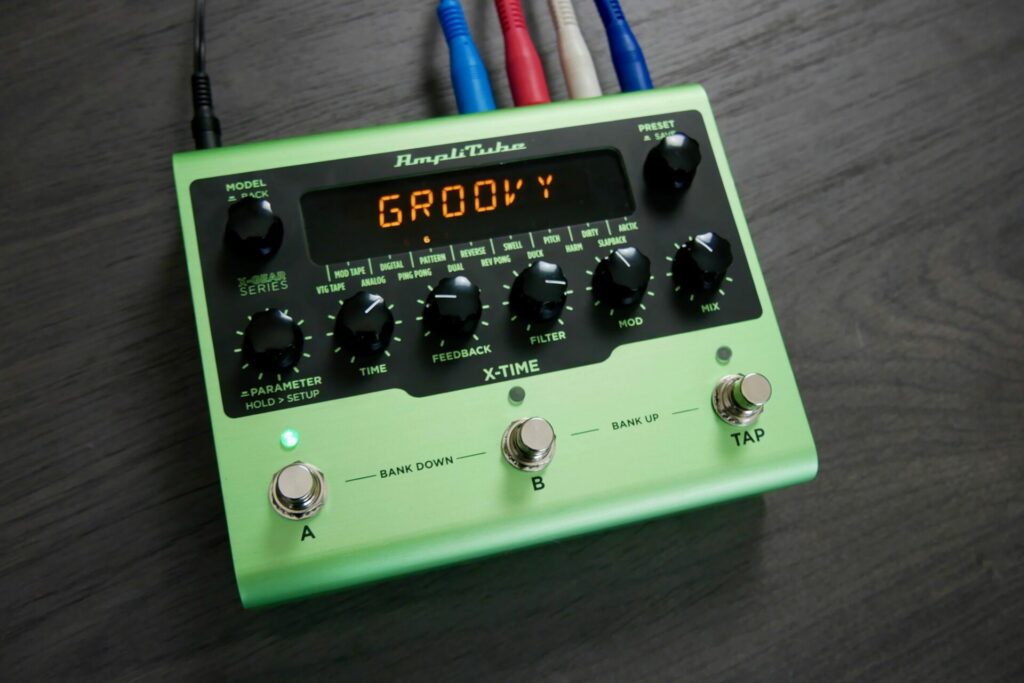
Unboxing
The pedal comes in a lovely light green cardboard box. Once unpacked, you discover the pedal, a matching 9V positive supply, and a card with a serial number that is important not to lose. Thumbs up for the included power supply in the box.
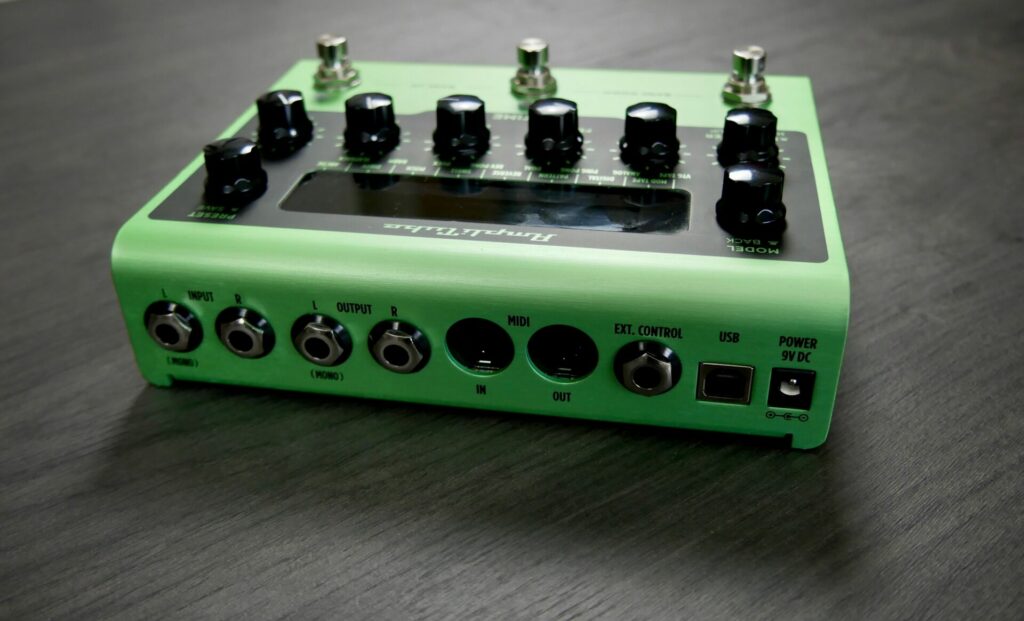
Connectivity
All connections are located on the back of the pedal. Here you can find two 6.3mm inputs and two outputs, a MIDI interface with in/out with classic sockets. Thus, no MIDI adapters are required, and there is also a socket for an expression pedal or footswitch. Logical, the AmpliTube can process mono to stereo and all stereo signals.
User interface
The user interface is identical to the X-SPACE pedal: 5 potentiometers, three endless rotary encoders, three switches, and an easy-to-read classic display form the design of the UI. The three encoders have an additional function, one initiates the preset storage process, one is for algorithms + back function, and the latter manages the sub-menu. Then, the five pots set the main parameters: time, feedback, filter, mod, and mix.
X-TIME has three multi-functional footswitches. They switch the effect on/off in a traditional way or serve as a control instance for the preset manager. You can navigate through the sound banks A + B together is bank down and B + C bank up. Don’t forget to explore this functionality. Otherwise, you will overlook the majority of the built-in presets. Different LEDs show you in which operating mode you currently are: preset active, preset edited, or bank browsing.
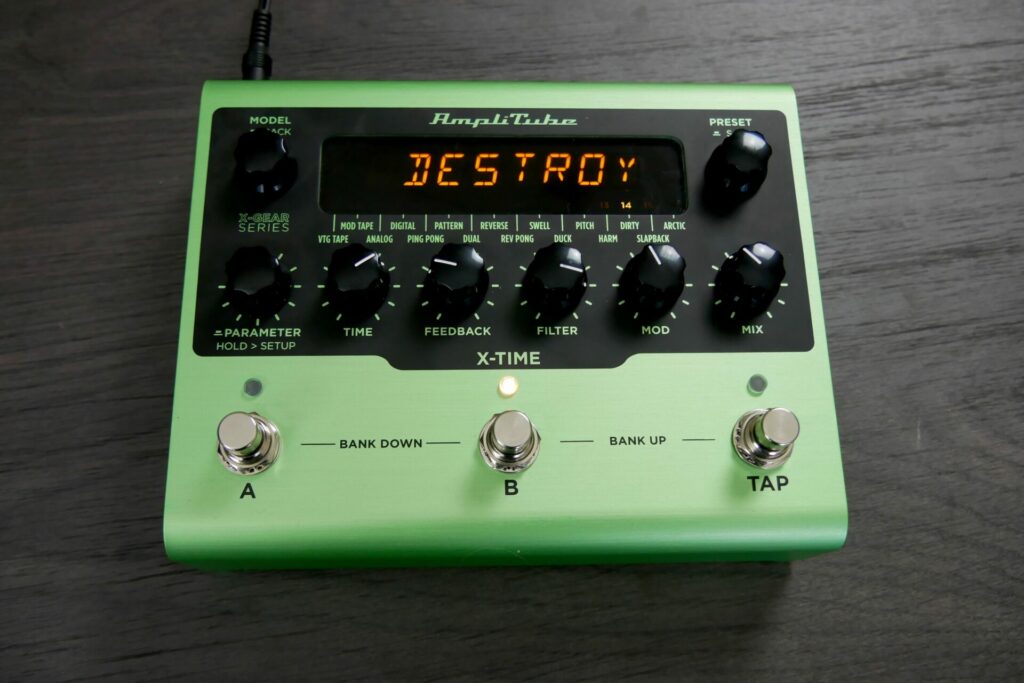
The middle footswitch also activates the unique X-Mode, and the right one allows tap tempo for creating tempo-synced repeats. It’s, however, not an easy thing. Especially for setting up sub-divisions, here is a very cumbersome, intuitive workflow. They are only available by turning the whole pedal into a different mode, and only then they appear on the Time knob. It’s not a very welcomed workaround.
The X-TIME also has hidden parameters that can be controlled with the left rotary knob. It is relatively easy with the X-Space; it is much more strenuous here because many algorithms take up several pages. You quickly lose track of where you are in the algorithm. That’s less hands-on.
Interface Improvements?
X-SPACE has a mixture of classic knobs and rotary encoders that are suboptimal. The same applies to the X-TIME pedal. I would also prefer here endless rotary knobs since they allow you to change parameters more precisely.
More precisely, if you tweak a parameter on the X-TIME, the edited value often changes deeper, positively or negatively.
A catch function would be helpful here so that you start tweaking where the parameter in the actual preset is. Or is there such a mode that prevents parameter jumps?
“Click there, then there again…” yes, the operation is initially a bit fiddly and irritating. This applies above all to calling up the sub-parameters and managing presets. It takes some getting used to, but it’s easier to use once you get the hang of it. But it could be user-friendly overall.
Technical
The X-Gear series features a state-of-the-art DSP chip that converts the signal to 24-bit/192kHz with a frequency response of 5Hz – 24kHz. The team of IK Multimedia has put on this core a plethora of interesting, inspiring algorithms.
Algorithms
There are 16 different ones, all with many parameters and so very extensively customizable. You get the usual vintage-inspired suspects, modern ones, to less familiar experimental programs; there is something for everyone.
- vintage tape: a classic tape echo with wobble effect
- mod tape: a modern take on the tape echo with additional modulation controls over the depth and speed
- analog: analog-modeled delay with saturation of console pre-amplifiers and high-pass/lowpass filters
- digital: a crystal clear digital delay with a doubler mode
- ping pong delay with the option to pan the repeats Left-Center-Right and add a groovy “circular” effect.
- pattern with 16 delay patterns made to find new rhythmic ideas, plus the last eight also features reversed repeats.
- dual: two delays in one with series/parallel configuration
- reverse delay with inverted repeat with excellent delay tails plus the option to mix a non-reversed repeat to make groovy patterns
- rev-pong: advanced ping pong delay. The delayed sound is sent to a reverb that can be modulated. Also, the second tap of the ping pong pattern can be reversed to get a very custom sound.
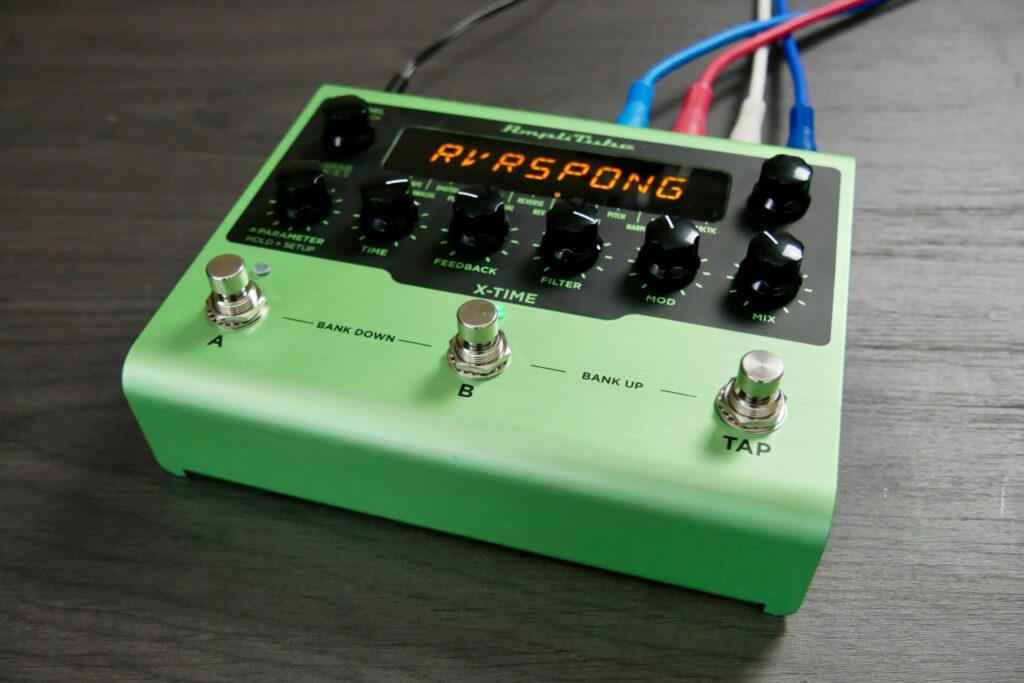
More Algorithms
- swell delays with independent swell effect parameters plus syncing and un-syncing options with the delay
- duck: a delay that makes it possible to have vast amounts of wet signal and feedback while retaining the dry signal focused on top by ducking down the delayed signal every time the dry signal is played.
- pitch: a delay that pitches up or down from the original tone to create pitched effects in the repeats.
- harm: a delay that harmonizes up or down from the original tone to easily create delayed chords by playing just one note, thanks to its double harmonator.
- dirty: a saturated and distorted delay powered by a phaser with independent speed and mix
- slapback: a take on the 50s slapback delays with a built-in modulated filter for adding it in the stereo field.
- arctic: a delay sent to a flanger and to a shimmer effect with lush and never-ending tails.
Plus, it hosts a cabinet simulator with five different IR-based cabinets—a feature for guitarists and bassists.
X-FACTOR
Yes, the AmpliTube X-TIME also features the “X-mode” that activates a particular functionality. You can start it by holding the footswitch while the preset is on. In most algorithms, it pushes the feedback to infinity and creates massive drones.
Exceptions are, for example, the slapback algorithm where the X-mode also raises the LFO resonances besides the unlimited feedback. A great functionality to make experimental sounds like drones or noisescapes. Be careful with the level; it quickly becomes loud and uncontrollable.
Librarian
The X-TIME pedal has a memory capacity of 300 locations for presets arranged into 100 banks of three presets each (A, B, C). The presets can be selected using the footswitches. That’s a lot of space for your patches. For the preset management (import/export), IK Multimedia ships the pedal with a free X-GEAR librarian software that also handles firmware updates.
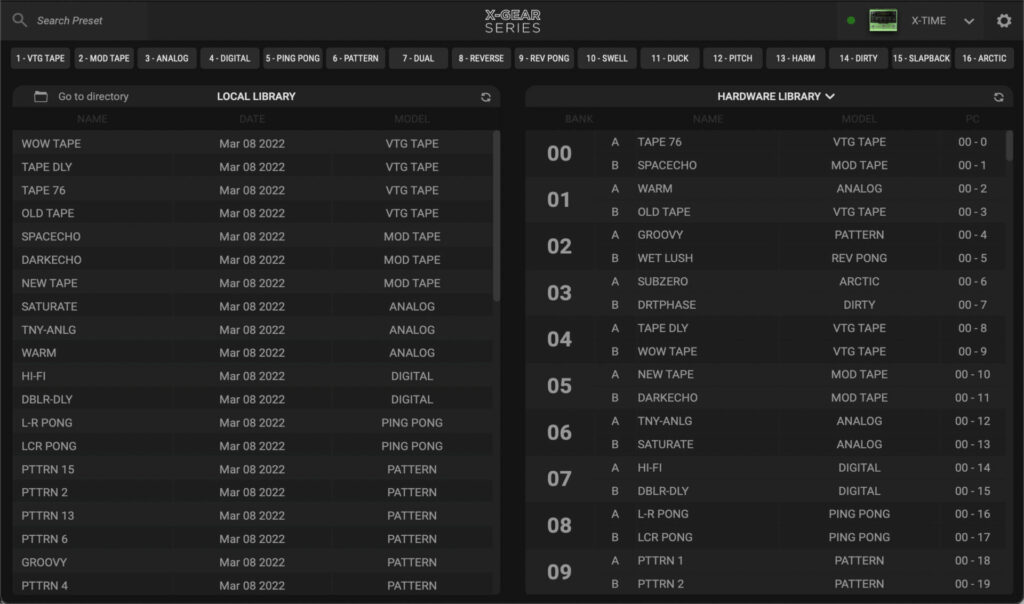
Attention, the librarian is not a fully-featured editor software for your DAW; it’s just a preset manager. An editor would be handy, especially with the delay, which goes deeper into the parameters than the space. The librarian can also be downloaded without registration, but there are good reasons to register your pedal.
AmpliTube Software Version
IK Multimedia gives every hardware pedal user the software version for free that can be used in the AmpliTube 5 CS plugin. To benefit from this offer, you need to register the hardware in your IK account using the producer manager app. Don’t worry; it gets done quickly. Once done, you have full access to the software version of the pedal.
The algorithms, as well as the parameters, are identical to the hardware pedal. The move by IK to make an ecosystem and give all hardware users the software version is pretty clever. So you can jam with your hardware, move on to your computer, and work with the same presets and sounds in your favorite DAW.
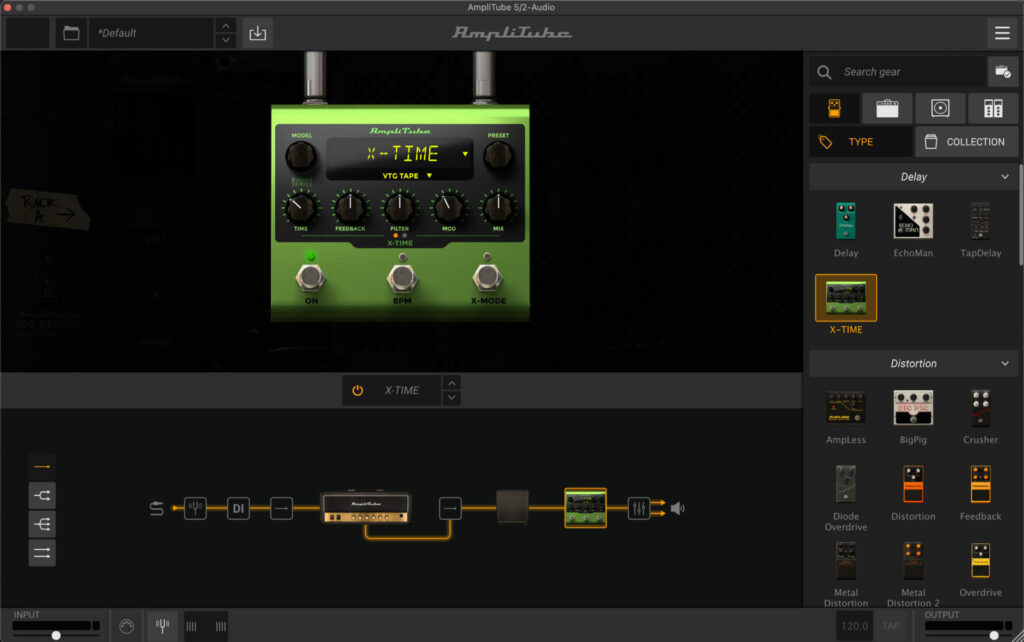
Like on the X-Gear SPACE, the registration concept remains a problem child. You have to register the hardware with a serial that is fixed in the account. If you decide to sell the pedal, you have to pay a license fee to free it and make the transfer to the new owner possible.
I can understand it with software, but it doesn’t make any sense with hardware, including synths or pedals. Please change this system. Companies like Native Instruments offer an automated license transfer service for hardware free of charge.
Audio Interface
There is also a cool hidden feature. In addition to the stereo delay power, the X-TIME is also a rock-solid two-channel USB audio/MIDI interface with up to 24kHz frequency response. You can send either the wet or dry signal to your DAW thanks to a clever routing system.
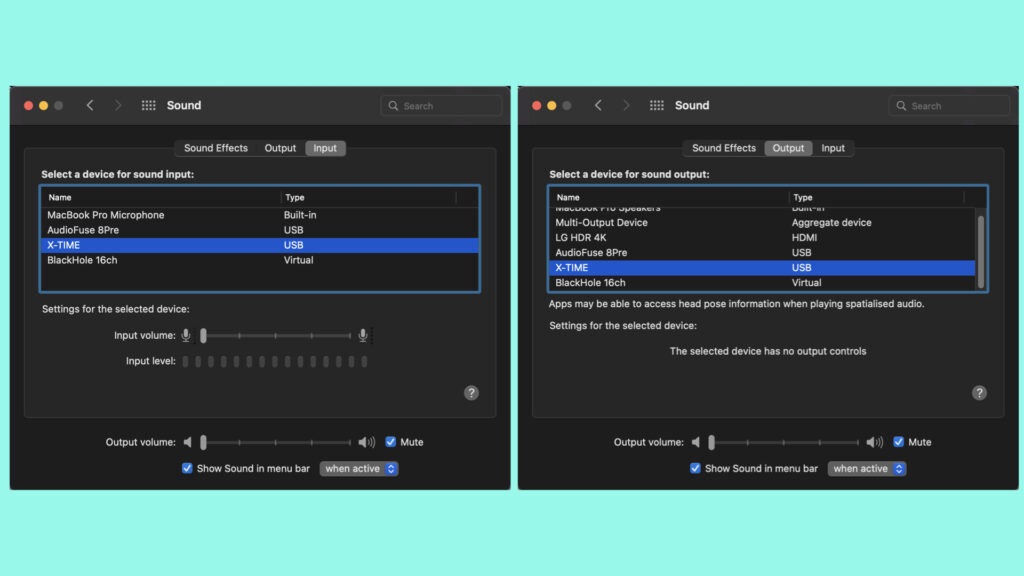
You have the stereo out for monitoring sound between the X-TIME pedal and your macOS and Windows computer. There is also a full MIDI implementation for AmpliTube or DAW mappings onboard. A neat extra feature that you get here. I can imagine it as a mobile interface when you’re on tour with your synths and pedals. So you always have a high-quality interface at hand.
Sound Demos
And, of course, sound demos should not be missing. In two sound demos, each 15 minutes + long, you will get an overview of how the X-GEAR Delay sounds connected with different synthesizers. Since Synth Anatomy is all about synths and electronic sounds, the pedal was also tested with these. Unfortunately, no METAL.
Sound Quality
The perfect or the best stereo delay pedal? You could write several books about it, and I think you would have forgotten a lot. And to be honest, I’m not the reviewer to go into spectrometer details on how pristine the quality of a delay, distortion, reverb, or modulation is.
However it’s important to know: I only fed the pedal with Synthesizer and other electronic sounds. Since pedals like to harmonize differently with other sonic content (guitar, bass…) it may react differently to these, giving you different effects results. Even though IK has fired its X-GEAR marketing bazooka less on electronic music, the X-TIME algorithms match perfectly with synthesizers. The classic ones as well as the crazier ones.
Especially the unusual programs like the harmonic, pitch and arctic are very inspiring with e-sounds. They add, for example, additional pitches or fast modulations to the repeats that gives you instantly unique blooming delay timbres. It’s like a 60s’ sonic trip you are on.
Tape Delay, available in vintage and modern, gives your electronic sounds a nice warm character. They range from pristine repeats to delays with extreme wobbly-like characteristics thanks to an internal modulation feast. Greetings from poorly maintained tape machines. I particularly enjoyed using the Pattern algo, with which you can quickly build a rhythm from any static synth sound.
There is also a high-quality reverse that reminds me of granularization in places. And number 14, the dirty algorithm is one of my favorites. It is powered by a fully-customizable phaser that takes you easily to saturated and distorted delayscapes.
The colorful mixture of old and new is a lot of fun. Here you travel back to the times of characterful, unstable tape echoes or BBDs and at the same time forward to the modern times of hybrid delays. Merging multiple elements into a delay algorithm. Only the duck and slapback algorithms couldn’t convince me with electronic sounds. But that can be different with guitars etc.
IK Multimedia X-DELAY Review – Conclusion
I can’t say much about the X-TIME that is different from the X-SPACE. It was able to convince in most points in the test. Also with Synthesizers! The X-TIME is rock-solid built and offers tons of inspiring algorithms with in-depth editing capabilities. Also the delay/echo codes have an excellent quality and can easily keep up with the high-price competition.
Out of the box, it ships with many useable factory presets who have big focus on unusual, experimental timbres. If you are looking for the bread and butter delay, you have to craft it first. Big like for the free of charge software version that lets you plug the pedal with the same functionalities into your DAW. A new concept that I very much welcome.
X-TIME follows the same path as the X-SPACE reverb pedal in my opinion. It is very comfortable in the ambient, atmospheric world. But you can easily escape from this world by building your own patches. The algorithms are of high quality and offer a lot of variety. The usability, not the best, especially with deep algorithms like the dual program.
In overall, it’s an impressive first stereo delay pedal from IK Multimedia. A toolbox for delays from the past, today and tomorrow packed with DSP power and a well-throughout concept.
Pro
- sound quality
- 16 versatile high-end algorithms ranging from classic, to modern up to experimental
- 300 presets memory + free librarian software
- 2-channel audio/MIDI interface
- software version for the AmpliTube plugin
- built like a tank
Neutral
- hopefully in future some new algorithms
Contra
- hardware product registration
- somewhat cumbersome menu diving (dual algorithm, sub-divisions for tap tempo…)
IK Multimedia AmpliTube X-Delay is available now for an MSRP of 395,99€ incl. tax. At retailers, you can find it already for 285€ at Thomann, or $329,99 USD incl. tax. Until May 2nd, you get all four X-GEAR software versions for AmpliTube 5 SE for free if you buy a X-GEAR pedal.
More information here: IK Multimedia
Available at our partners

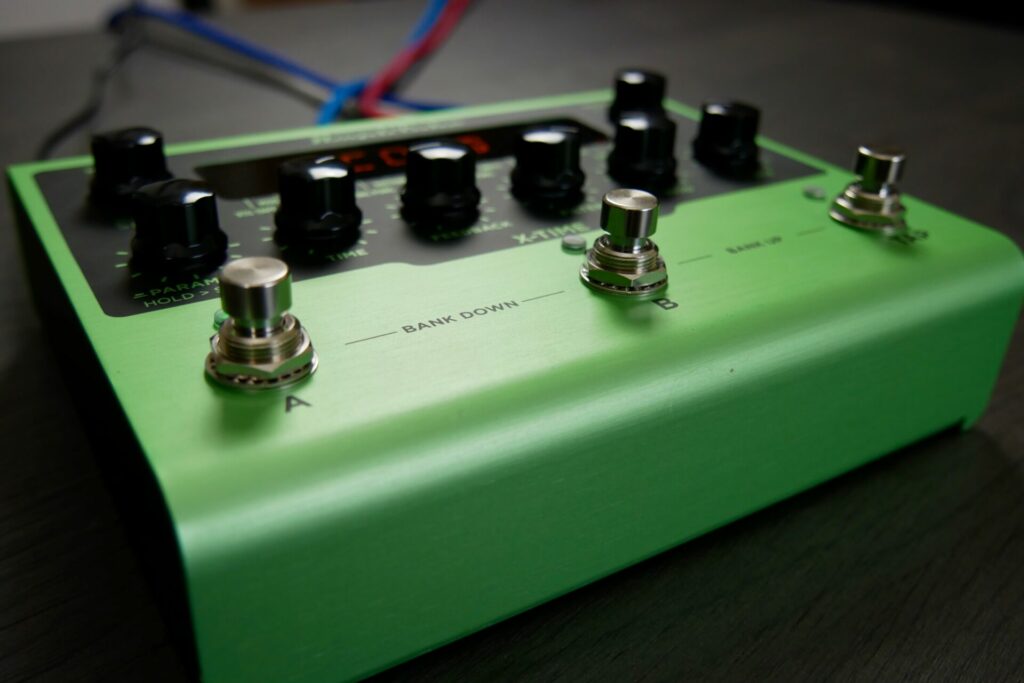

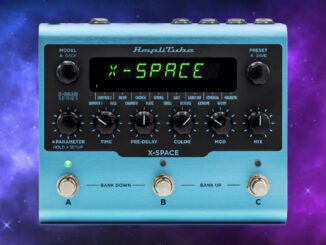

I’ve used this device since a week now and agree with all the points you raise in the review – good work! I watched many youtube videos first before buying but almost all were just extended ads with youtubers gushing as they go from preset to preset.
Thankyou for something more in-depth and honest!!!
Overall I’m not so happy with this pedal. I thought it might be a Timeline for cheap but am very disappointed.